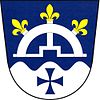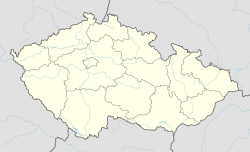Jindřichov (Šumperk District)
| Jindřichov | |||
|---|---|---|---|
| Municipality | |||

Paper mill
|
|||
|
|||
| Coordinates: 50°6′9″N 16°59′21″E / 50.10250°N 16.98917°ECoordinates: 50°6′9″N 16°59′21″E / 50.10250°N 16.98917°E | |||
| Country |
|
||
| Region | Olomouc | ||
| District | Šumperk | ||
| Area | |||
| • Total | 51.7 km2 (20.0 sq mi) | ||
| Elevation | 460 m (1,510 ft) | ||
| Population (2006) | |||
| • Total | 1,411 | ||
| • Density | 27/km2 (71/sq mi) | ||
| Postal code | 788 23 | ||
| Website | http://www.jindrichovsu.cz | ||
Jindřichov (German: Heinrichsthal) is a village and municipality (obec) in Šumperk District in the Olomouc Region of the Czech Republic.
The village is named after Heinrich (Czech: Jindřich) Kaiser, a second owner of a local paper mill.
Whole municipality (nearby administered villages included) covers an area of 51.7 square kilometres (20.0 sq mi).
Jindřichov lies approximately 16 kilometres (10 mi) north of Šumperk, 60 km (37 mi) north of Olomouc, and 184 km (114 mi) east of Prague.
The village is situated above Branná in a narrow valley surrounded by Hanušovická vrchovina (literally Hanušovice Highlands) and High Ash Mountains. The nearby landscape is composed of coniferous forests, steep hills, Branná floodplains and meadows. Houses are built along a transregional road and a relative busy railway because the Branná valley is one of the few routes from Jeseník District to the rest of the Czech Republic.
Jindřichov administers the nearby villages and hamlets.
Jindřichov is a young village founded in 1953. A settlement in the place existed before this date but it was not officially recognized and was considered to be a part of Nové Losiny.
A history of Jindřichov was started in 1862 when a paper mill and an apartment building for workers were built. An investor was Joseph Abraham Winternitz. The place was chosen because of the rich water source the Branná River and deep forests which can be exploited for cellulose.
A railway access with rest of Austria-Hungary was opened in 1888 as well as an access with Prussia via Hlucholazy what caused a growth of factory production and thus building of new workers' apartments and necessary infrastructure. The factory had 750 employees in 1920. Its functioning caused strong pollution of Branná river. Because the Communist government wasn't really interested in environmental problems, the situation went better in the late 1990s.
...
Wikipedia



